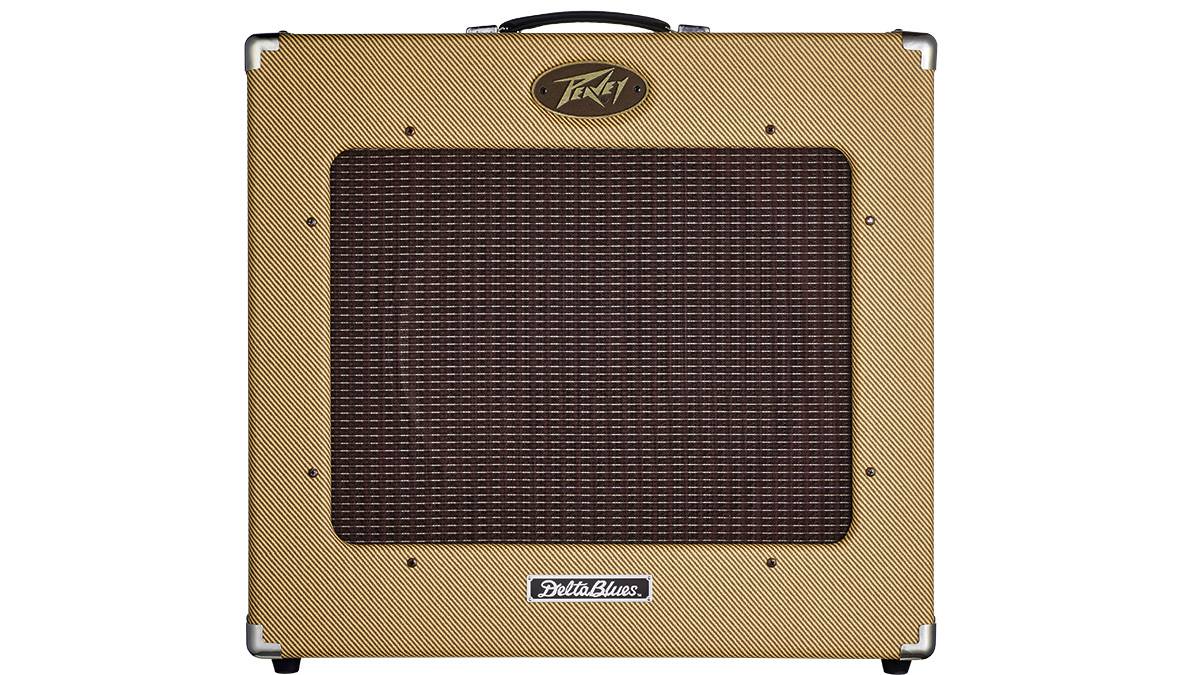MusicRadar Verdict
Aimed at the working musician, the Delta is made to look good, sound good and keep going with minimal attention.
Pros
- +
Extended, powerful tone from the 15-inch driver; nice reverb and excellent tremolo; very loud.
Cons
- -
It's expensive and quite heavy.
MusicRadar's got your back
We recently reviewed Peavey's revamped Classic 50, and now here comes the Delta Blues.
The Delta Blues is available in a 2x10 format, but the most popular choice is the original 1x15 - one of just a handful of production guitar amps to use this size driver. A 15-inch loudspeaker extends the amp's bass response and shifts the most active frequency range down a little, for a tone that really punches through in a live gig environment.
Meanwhile, the Delta retains its very vintage 'TV' front. The twill covering has been very neatly applied and sits nicely with the brown/gold speaker grille cloth and chrome steel chassis - unmistakably influenced by Fender's tweed amps of the 1950s, which are often quoted as the genesis of the modern guitar amplifier.
The famous Peavey Blue Marvel loudspeakers have been replaced by a 15-inch Celestion Fullback. Stephens was a cult USA hi-fi loudspeaker brand in the late 1950s that appears to have been resurrected by Peavey for more general- purpose use.
Inside the chassis, this amp sports a typically clean and neat printed circuit board, which hold most of the electronics; there's also a slightly redesigned layout that should help to improve long-term reliability.
There's a volume control for the clean 'normal' channel and old-style Peavey 'Pre' and 'Post' gain and volume for the drive channel, together with a reverb level control and bass, mid and treble knobs.
In comparison to the Classics, the Delta Blues has two extra knobs to control the speed and intensity of its tremolo effect, otherwise its functions are identical to the Classic 30.
It's good to see Peavey has kept the very useful series effects loop on this amp and added a standby switch, while the footswitch and extension speaker sockets are on the back.
The overall vibe is still typical Peavey: built to handle the kind of use and abuse that a busy working musician typically dishes out, while looking clean and refined. Each amp includes a two- button footswitch for changing channels and operating the boost function; an extra footswitch is needed to control the reverb and the Delta Blue's tremolo effects.
Sounds
The Delta is well behaved electrically, with practically inaudible hum, low hiss and pop-free switching.
Peavey's often-overlooked clean channel has a great all-purpose voicing that's equally flattering for single coils and humbuckers, sitting perfectly in the mix for many different musical genres. There's a hint of overdrive as you turn up, which adds a subtle edge to chords and single notes. Used with a Strat or Tele, this is ideal for country picking.
The 'quack' of the in-between switch settings on a Strat sound especially prominent, with a snappy treble and fast attack. Swapping to a Les Paul or an archtop and using the neck pickup with a touch of reverb provides an excellent jazz tone - warm but with a slight growl that can be used for emphasising phrases when you pick harder.
Meanwhile, bridge humbuckers sound great for rockabilly and redneck jazz, while using both pickups together on a Les Paul or Tele generates a superb buttery rhythm sound that's perfect for funk chord riffs. A very smooth tremolo circuit adds to the Delta's vintage appeal.
The Delta Blues' 15-inch Celestion adds extra lows for increased punch. Add a decent archtop, select the bridge pickup and it's instant rockabilly heaven, with a medium fast attack that's perfect for flat- and fingerpicking.
The Delta Blues' tonal range makes a big impact on chords and licks here, and works really well with lap steel and slide. The tremolo is excellent and perfect for adding character and colour to any classic pop or rock genre.
The amp appears to have benefited from a number of circuit improvements that haven't changed the sound but have had a positive effect on performance.
“I said, ‘Are we sure we can write a song about death?’”: The story of Mike + The Mechanics' classic No.1 The Living Years
“Without investment in music education our talent pipeline is at risk of drying up along with the huge opportunities for economic growth it brings”: UK Music draws up five point plan to “turbocharge” music education
“How daring to have a long intro before he’s even singing. It’s like psychedelic Mozart”: With The Rose Of Laura Nyro, Elton John and Brandi Carlile are paying tribute to both a 'forgotten' songwriter and the lost art of the long song intro










